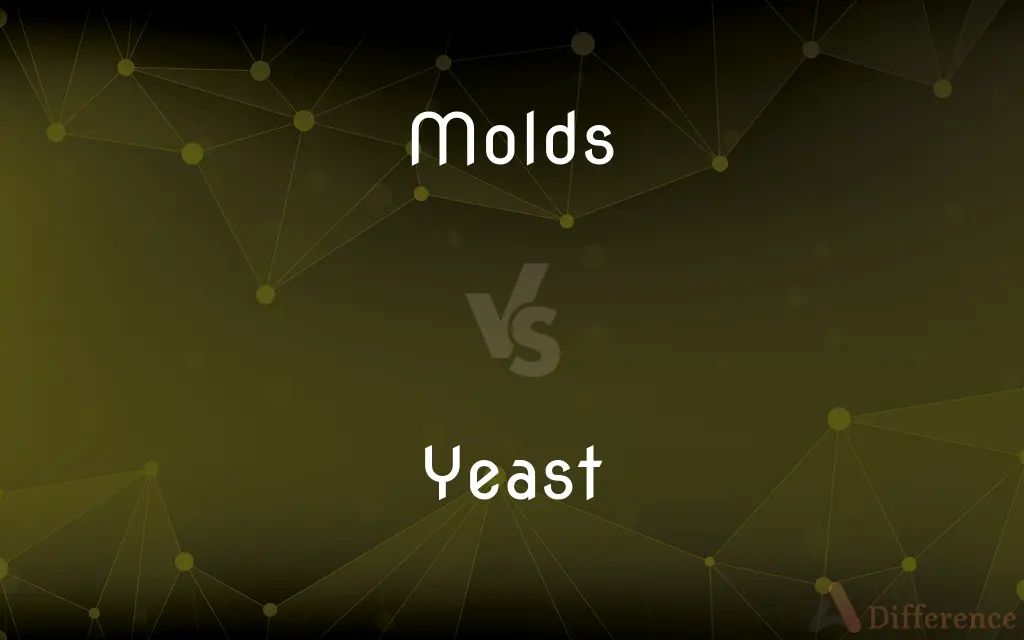Molds vs. Yeast — What's the Difference?
By Tayyaba Rehman — Published on January 18, 2024
Molds are multicellular fungi that grow in filamentous structures, while Yeast is a single-celled fungus used in fermentation and baking.

Difference Between Molds and Yeast
Table of Contents
ADVERTISEMENT
Key Differences
Molds are fungi that appear as fuzzy growths, often seen on food and in damp environments. Yeast, being single-celled, is invisible to the naked eye and is commonly used in food production.
Molds often cause food spoilage and can produce allergens and toxins. Yeast, on the other hand, is beneficial in food industries, particularly in baking and brewing, for fermentation.
Molds grow in the form of multicellular filaments called hyphae, creating a network known as a mycelium. Yeast, being unicellular, exists as individual cells that can sometimes form small clusters.
While molds can thrive in various environments, including soil and decaying matter, yeast is more commonly found in sugary environments like nectar or on fruit skins.
Comparison Chart
Cellular Structure
Multicellular, forming filaments (hyphae)
Single-celled
ADVERTISEMENT
Common Usage
Often associated with spoilage and decay
Used in fermentation, baking, and brewing
Visibility
Visible fuzzy growths
Invisible to the naked eye
Growth Environment
Thrives in various environments, including damp areas
Common in sugary environments like fruits
Compare with Definitions
Molds
Fungi that grow in multicellular filaments called hyphae.
Molds were found growing on the damp walls.
Yeast
A single-celled fungus used in baking and brewing.
Yeast is essential for making bread rise.
Molds
Reproduce by releasing spores.
Molds spread in the house by releasing spores into the air.
Yeast
Invisible to the naked eye and used in food production.
Yeast is mixed with flour and water to make dough.
Molds
Often found in damp or decaying environments.
Molds are common in compost piles due to the decaying organic material.
Yeast
Commonly found in sugary environments like on fruits.
Natural yeast can be found on the skins of grapes.
Molds
Commonly known for causing food spoilage.
Molds spoiled the bread left outside the refrigerator.
Yeast
Converts sugars into alcohol and carbon dioxide in fermentation.
Yeast is used in brewing beer to ferment the sugars.
Molds
Can produce allergens and toxins.
Molds in homes can cause allergic reactions in some people.
Yeast
Any of numerous fungi that exhibit a one-celled growth form and reproduce by budding, including certain candidas that can cause infections in humans.
Molds
A hollow form or matrix for shaping a fluid or plastic substance.
Yeast
Froth consisting of yeast cells together with the carbon dioxide they produce in the process of fermentation, present in or added to fruit juices and other substances in the production of alcoholic beverages.
Molds
A frame or model around or on which something is formed or shaped.
Yeast
A powdered or compressed commercial preparation of yeast cells, used chiefly as a leavening agent or as a dietary supplement.
Molds
Something that is made in or shaped on a mold.
Yeast
An agent of ferment or activity
Political agitators who are the yeast of revolution.
Molds
The shape or pattern of a mold.
Yeast
An often humid, yellowish froth produced by fermenting malt worts, and used to brew beer, leaven bread, and also used in certain medicines.
Molds
General shape or form
The oval mold of her face.
Yeast
A single-celled fungus of a wide variety of taxonomic families.
Molds
Distinctive character or type
A leader in the mold of her predecessors.
Yeast
A true yeast or budding yeast in order Saccharomycetales.
Molds
A fixed or restrictive pattern or form
A method of scientific investigation that broke the mold and led to a new discovery.
Yeast
Candida, a ubiquitous fungus that can cause various kinds of infections in humans.
Molds
(Architecture) See molding.
Yeast
(figuratively) A frothy foam.
Molds
Any of various filamentous fungi that grow on and contribute to the decay of organic matter.
Yeast
To ferment.
Molds
A growth of such fungi.
Yeast
(of something prepared with a yeasted dough) To rise.
Molds
Any of various other saprophytic or parasitic organisms that resemble fungi, such as slime molds or water molds.
Yeast
To exaggerate.
Molds
Loose friable soil, rich in humus and fit for planting.
Yeast
The foam, or troth (top yeast), or the sediment (bottom yeast), of beer or other in fermentation, which contains the yeast plant or its spores, and under certain conditions produces fermentation in saccharine or farinaceous substances; a preparation used for raising dough for bread or cakes, and making it light and puffy; barm; ferment.
Molds
The earth; the ground.
Yeast
Spume, or foam, of water.
They melt thy yeast of waves, which marAlike the Armada's pride, or spoils of Trafalgar.
Molds
(Archaic) Earth as the substance of the human body.
Yeast
A form of fungus which grows as individual rounded cells, rather than in a mycelium, and reproduces by budding; esp. members of the orders Endomycetales and Moniliales. Some fungi may grow both as a yeast or as a mycelium, depending on the conditions of growth.
Molds
To form (something) out of a fluid or plastic material
Molded a cup out of clay.
Yeast
A commercial leavening agent containing yeast cells; used to raise the dough in making bread and for fermenting beer or whiskey
Molds
To form into a particular shape; give shape to
Molded the clay into a ball.
Molds
To guide or determine the growth or development of; influence
A teacher who helps to mold the minds of his students.
Molds
To fit closely by following the contours of (the body). Used of clothing.
Molds
To assume a certain shape
Shoes that gradually molded to my feet.
Molds
To become moldy.
Molds
Plural of mold
Molds
Infl of mold
Common Curiosities
Are molds harmful?
Some molds can produce harmful toxins, but not all are dangerous.
Are molds visible to the naked eye?
Yes, molds appear as visible fuzzy growths.
Can molds grow on any food?
Molds can grow on many foods, especially if they are moist and not properly stored.
Can molds cause allergies?
Yes, mold spores can trigger allergic reactions in sensitive individuals.
How quickly do molds spread?
Molds can spread quickly under suitable conditions like warmth and moisture.
Do molds and yeast have the same growth requirements?
No, their growth conditions vary, with molds being more versatile in different environments.
Can yeast be used in winemaking?
Yes, yeast is essential in the fermentation process of winemaking.
Is yeast harmful to humans?
Generally, yeast is safe and beneficial in food production.
What is yeast commonly used for?
Yeast is commonly used for baking bread and brewing alcohol.
How does yeast help in baking?
Yeast ferments sugars, producing gas that makes dough rise.
Can yeast spoil food?
Yeast can cause spoilage in certain foods, like fermenting fruits.
What are the ideal conditions for mold growth?
Molds thrive in warm, moist, and humid conditions.
Can yeast infections occur in humans?
Yes, certain types of yeast can cause infections in humans, like Candida.
Can molds be beneficial?
Some molds are used in medicine and food production, like penicillin and cheese making.
Can yeast be found in the environment?
Yes, yeast is naturally present in the environment, especially on plant surfaces.
Share Your Discovery

Previous Comparison
Sympathetic Nervous System vs. Parasympathetic Nervous System
Next Comparison
Kingston HyperX vs. Crucial BallistixAuthor Spotlight
Written by
Tayyaba RehmanTayyaba Rehman is a distinguished writer, currently serving as a primary contributor to askdifference.com. As a researcher in semantics and etymology, Tayyaba's passion for the complexity of languages and their distinctions has found a perfect home on the platform. Tayyaba delves into the intricacies of language, distinguishing between commonly confused words and phrases, thereby providing clarity for readers worldwide.
















































